| |
|
Qiyun Mountain China
Located in Xiuning County - Anhui Province |
|
Qiyun Mountain is a Taoist Holy
Site, a National Forest and a National Geological Park |
|
Qiyun in Chinese means "As High as
the Clouds" |
|
According to Historical Records
The Top of the Mountain was always Enveloped in White Clouds
So it was also "White Mountain" |
|
The World's Most Remote Temple
Taoist Shrine - Stands on top of a 5,460 foot peak
in China! |
|
The Temple has been 'Sitting on the
Peak' of Tayun Mountain, in Shaanxi Province, since the 1500s |
|
Tayun Mountain is "One of the Most Famous Peaks"
associated with Taoism |
|
Revealed - The 'Hidden Beauty' of a Taoist Temple
Sitting on a Peak in Northwest China |
'Ta' (Pagoda) and 'Yun' (Clouds)
names the Mountain
Tayun Mountain is known for its steep peaks and is viewed as
a "Holy Land of Taoism".
Its main peak, Golden Peak, is 1665.8 meters (5,465 feet) above sea
level. |
|
The Buildings have a History . . . Dating back some
500 years
Temple is Classified as 'Secondary Cultural Relics' |
|
This tiny Temple with an area of less than six square
meters (64.5 square feet) has its four stone pillars rooted in the
mountain's rocks.
Since the reign of Emperor Qianlong in the Ching Dynasty (1644-1912).
The Temple buildings have been repaired and renovated five times. |
|
It is said to be one of the . . . "Most Dangerous
Mountain Temples in the World" |
|
Stone strips have been stacked up to make the foundation of the
Temple. |
|
The Isolated Temple has a 'Golden Top' |
|
The Temple is dedicated to Kuan Yin (Goddess of
Mercy). |
|
Built in the Zhengde Period of the Ming Dynasty |
|
The cluster of ancient Taoist buildings also includes
a guesthouse, a pagoda, a hall, and nine palaces.
Taoism, with a history of more than 2,600 years, is one of the
mainstream traditional religions in China.
It places a strong emphasis on respect for nature as it advocates the
worship of natural objects including mountains.
Currently, there are more than 1,500 Taoist Temples in China. |
|
One of China’s Five Sacred Mountains
Mount Hua is in Central China Shaanxi Province
An Ancient Center of Taoism
Hua Shan has always been Steeped in Religious History
Ever Since a Taoist Temple was First Built at its Base in the 2nd
Century BC |
|
Hua Shan Mountain is known as "The
Number One Precipitous Mountain under Heaven"
There are Five Sacred Mountains in China
The other Four Sacred Mountains are:
Mt. Taishan in Shandong, Mt. Hengshan in Hunan, Mt. Hengshan in Shanxi,
and Mt. Songshan in Henan |
|
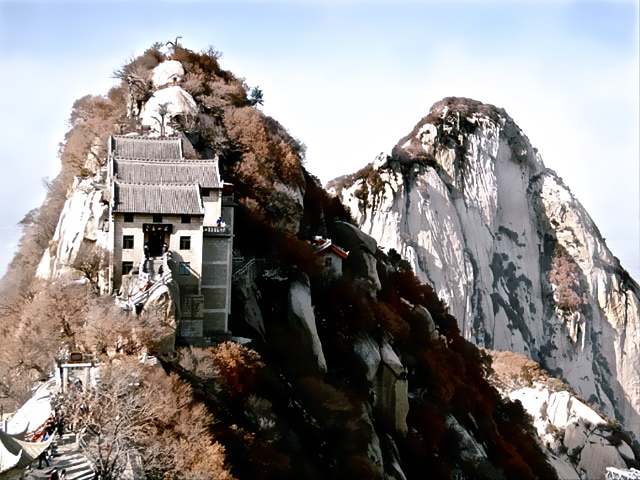 |
From a distance the five peaks seem to form the shape of
a 'flower' (hua in Chinese), hence the name 'Hua Shan'. It is famous for
its natural vistas of steep and narrow paths, precipitous crags, and a
high mountain range. It is well-known also for its sheer cliffs and
plunging ravines, which makes it the most dangerous mountain in China
for climbers. It is home to several influential Taoist Temples where
Emperors of past Dynasties made Pilgrimages, making Mt. Hua Shan the
Holy Land of Taoism.
Hua Shan is unique amongst the five great Taoist
Mountains in that it is the only absolutely pure Taoist Mountain, free
from the intrusion and presence of any other religions. Hua Shan boasts
many Taoist religious heritages as Temples, Pavilions, Buildings, and
Scriptures are scattered around everywhere, intermixed with famous
historical sites.
It is a place steeped in legend, where the very rocks
are engraved with tales and poems from its long history; where gods are
said to have performed magic, where emperors have worshipped and
sacrificed; and where forefathers of Taoism have set down their
religious legacies.
|
|
Hua Shan Mount |
Of the Five Peaks on the Mountain 3 are the Most
Famous |
| These are Sunrise Peak (East Peak). Sunrise Peak is a fine place to
enjoy the sunrise view in early morning. Hua Shan means Flower
Mountain and it has the Lotus Flower Peak (West Peak), which
resembles a beautifully blooming Lotus Flower. Falling Goose Peak (South
Peak), is the highest among the five. The path to the summit is nearly
vertical, which now is equipped with iron chains to protect climbers.
The climb makes it clear how the impenetrable mountain repelled invaders
over centuries. |
| Across the whole mountain are scattered 72 caves and 21 remains of
Taoist buildings. The caves are the ideal places for the Taoists to
meditate since they are completely inaccessible to ordinary people.
Taoism believes that the tranquility is an essential prerequisite to the
exploration of the Tao. Taoists in Hua Shan have made great
contributions to the development of Taoism. Among the great Taoists
associated with Hua Shan is Mr. Chen Chuan in the Northern Sung
Dynasty. He created a profound tradition of Internal Alchemy
and is honored as one of the Taoist Ancestors. He carved the Diagram
of the Ultimateness into the rock face near where he meditated on
the Inner Alchemy.
Taoism seeks to organize Body, Mind & Spirit to nurture life. It is
an Art called “Yang Sheng”. Adjusting the lifestyle through
meditation, environment, diet, exercise to create well-being. Through
these, one becomes aligned with nature and those who are deeply in touch
with themselves will naturally express ethics and morality. |
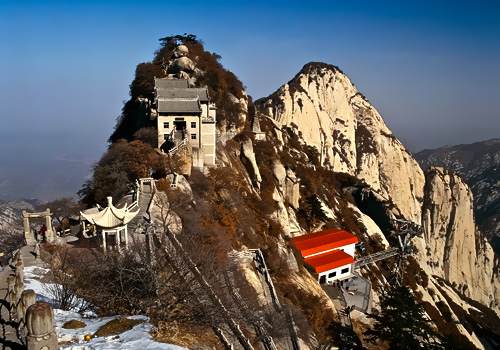 |
|
Middle Peak (Jade Maiden Peak) |
Jade Maiden Peak |
Middle Peak clings to East peak and is in the center of East,
South and West Peaks. There is a Taoist Temple on the peak named 'Jade
Maiden Temple'. Legend has it that the daughter of Qin Mugong (569
BC - 621 BC) loved a man who was good at playing Chinese Tung-hsiao
(Vertical Flute) and she gave up the royal life to become a hermit who
cultivated her spirituality here, hence the name Jade Maiden Peak.
Today Jade Maiden Temple and Jade Maiden Basin can be found on the peak.
Other renowned spots on Middle Peak include the Rootless Tree and the
Sacrificing Tree, which have beautiful stories associated with them, and
add to the supernatural atmosphere of Jade Maiden Peak. |
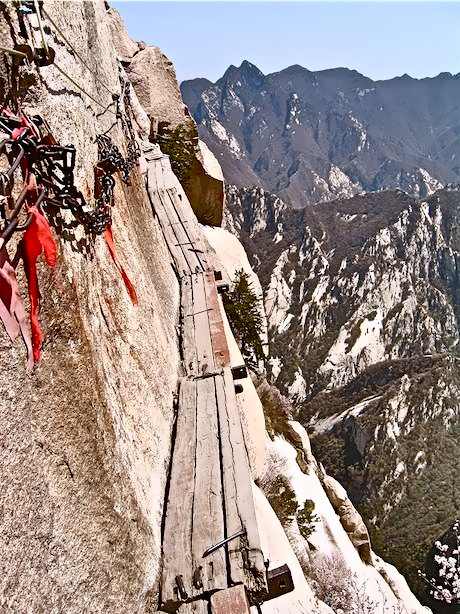 |
Pathway to the Taoist Temple
Imagine yourself clinging to a cliff face with nothing
but uneven, worn wooden planks and chains to keep you from plummeting
7,000 feet to your death. Don’t worry: You can rent a little red safety
harness for $5, but no one will make you wear it. And you will probably
encounter someone coming the other way, in which case you will have to
maneuver around your neighbor as if playing a deadly game of Twister.
Someone has to go on the outside, so you better be good at not blinking
first.
The plank-walk, sometimes called “the most dangerous
trail in the world,” is along the path to a pot of tea at a Taoist
Temple called Cuiyun Palace. Which is fitting, because the “Tao,” which
translates as “the path” or “the way,” will always lead you to tea.
Taoism is China’s indigenous spirituality, dating back to the 4th
Century BC, when Lao Tzu, the author of the Tao Te Ching, was said to
have been served the first cup of ceremonial tea. Taoists seek
harmonization with nature. Not only outer nature, but also inner nature.
Tea is part of that integrated path of well-being. It is deeply linked
with the Taoist search for longevity, spiritual wisdom, and health.
Meditation is vital to reach this state, and tea is at the center of it.
Drinking tea with a quiet mind and awareness allows the senses to open
and then to stop, look and listen. The true taste of tea reveals itself
only to those who learn how to relax their bodies and still their minds.
On Mount Hua, the water is pristine. Excellent for making tea. It comes
from snowmelt, rain and mountain springs. |
|
A Foot-wide Path made of Wooden
Planks winds around the Surface of a Cliff |
“Cha Yi” |
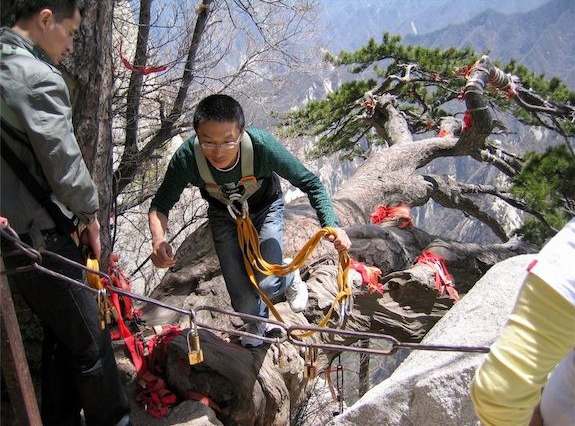 |
The Chinese don’t use the term “Tea Ceremony” in a way that involves
religious symbolism and an exact choreography. Rather, they use the
phrase “Cha Yi” or “the Art of Tea.” The practice is more
flexible, with general rules aimed at creating an aesthetic experience
in which the mind, body and spirit are all involved and focused.
The purpose of the ceremony is to find how you can maximize your
experience, from what kind of utensils you use, to how you prepare the
water, to the amount of tea you put in the cup. The only rules are those
that are necessary to bring out the flavor of the tea.When you have a
Taoist Monastery, or a place of meditation like Hua Mountain, or a place
where they’re simply serving tea in an area that is appreciative of
Taoism and Chinese Arts, the very fact that they’re serving it with
healing and meditative intent changes the effect on the people who drink
it, especially amidst the atmosphere the five peaks create; the shape of
a Lotus Flower being revered by Taoists for its wisdom and openness. |
|
Better View - At the end of a Tree
Jutting out of the Cliff |
|
|
Steep Staircases Carved into the
Mountain Itself |
You can get a Cup of Tea - At Cuiyun
Palace on the West Peak |
|
Jade Spring Temple (Yuquan Yuan) |
| Jade Spring Temple is the base Temple at Hua Shan, located at
the foot of the mountain. Jade Spring is one of the main Taoist Temples
in China. It has the architectural style of the classical gardens in
South China. There is a pond in the center and several pavilions around
it. Walking through the Wuyou Pavilion, the Long Corridor of Seventy-two
Windows comes into view. Further, a big rock can be seen. Beside the
rock are the precipitous 370 rock steps considered to be the primary
breath-taking path of Hua Mountain.
Sometimes porters carry supplies to the summit. A porter, whose
average age ranges from 30 to 60, navigates the treacherous trails while
carrying up to 175 pounds of construction materials, food, water and
rubbish on his back. But better-maintained trails, wider paths, railings
and a cable car that goes halfway up the mountain have made the climb
more accessible and has taken some of the strain off porters. |
|
Pilgrim
Trail in China
Kills at Least 100 People Every Year |
| Located on Hua Shan Mountain in Huayin in Shaanxi Province in the
Northwest part of the country. Known as the 'Mount Hua Skywalk',
the network of trails was made with wooden boards, ropes, chains and
seemingly any other materials builders could get their hands on. It’s
been used for centuries by Taoist monks and followers of the faith
visiting the mountain, which is considered holy in China. |
|
This Is Drone Footage
One of the "World's Most Dangerous" Hiking Trails
Aerial view of a plank 'Walk in the Sky'
Mount Hua in Shaanxi, China |
| The route has become overrun with tourists as you can
see from this drone footage captured by a Chinese television station. |
|
Chinese say,
“China has Five Sacred Mountains, but Wudang surpasses them all” |
|
Wudang Mountain is number one in the
hierarchy of Sacred Taoist Mountains |
Wudang is a mountain range with 27 peaks, covering over 200 square
miles. The main peak, Tianzhu, has an altitude of 1,612 meters. Wudang
Mountain has rich plant resources. About 600 of the 1,800 medicinal
herbs recorded in the Compendium of Materia Medica, compiled by the Ming
Dynasty scientist Li Shizhen, can be found in the area. The mountain's
rugged peaks are covered in old-growth forest, along with its ancient
monasteries, some built to fit the contours of the cliffs. The complex
was designed to fit the Taoist principle of harmony between man and
nature. Its buildings are cited as a museum of ancient Chinese design
and thought. A thousand years of lightning, storms and winds only make
them more empowered.
Magnificent Taoist buildings are distributed all over the mountain.
There are more than 2,000 Palaces and Temples, making this complex the
world’s largest Taoist center. Monasteries on the summit have long been
known as an academic center for the research, teaching and practice of
meditation, Chinese martial arts, traditional Chinese medicine, Taoist
agriculture practices and related arts. |
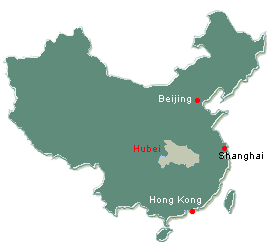 |
| Monasteries and buildings on the summit are a UNESCO World Heritage
Site. |
Wudang Mountains
Located in Central Hubei Province |
Wudang, since time immemorial, is a center for Chinese Martial Arts.
Influenced by the Taoist idea of "self-protection and self-cultivation
in isolation", the skills of Wudang Kung-fu are characterized by
not taking the initiative in an attack, as "removing is fighting, and
fighting is removing". Wudang Mountain is a birthplace of Internal
Martial Arts where the great Taoist Zhang San Feng came to live as a
hermit and learn the Taoist Methods of Immortality.
Taoist ritualistic activities follow a set of procedures handed down
through generations of Taoist Monks. The Monks recite ancient scriptures
and play Taoist music, following a centuries-old formula. Taoist music
has been extensively studied by scholars and experts. There is merry
music, praying for lucky and happy events, and also some graceful
rhythm, depicting concentrative ascetic practice.
"Listen to Fairy Music and appreciate Immortal
Doctrine, and then you will enjoy the pleasure that only exists in
Paradise" |
|
Autumn -
Oranges turn yellow and the smell of sweet-scented Osmanthus fills the
air. |
|
Picturesque Qingcheng Mountain |
|
Qingcheng Mountain is a famous Taoist mountain, and
is one of the places where Taoism was originated.
The mountain was enrolled into the UNESCO World Heritage List in 2000.
Qingcheng Mountain has a beautiful peak near the city, and another peak
sits behind it.
It can be experienced differently depending which path you choose.
Qingcheng Mountain: A major travel highlight in Chengdu due to its
numerous ancient Taoist and Buddhist Temples.
It was once a religious pilgrimage destination. |
|
Royal Taoist Temple to Open in 2016 |
|
Dagaoxuan Hall, part of the Forbidden City, opens
to the media and researchers of ancient buildings on August 13, 2014.
The Hall, served as the only Royal Taoist Temple during the Ming and
Qing Dynasties (1368-1911) in ancient China.
The Hall, built in 1542 during the reign of Emperor Jiajing of the Ming
Dynasty, will open to the public in 2016 after restoration.
It has been sealed up for more than 60 years. |
|
T'ien Hau
Taoist Temple - China Town Los Angeles |
|
This Los Angeles Chinatown Temple is one of 1,000
temples worldwide dedicated to the Goddess Mazu. While the “mother”
temple is in Fukian province of China, smaller temples can be found in
many areas in the south of Vietnam, southern China, and wherever peoples
from these regions have settled, including Los Angeles. |
|
T'ien Hau Temple - Los Angeles
750-756 N. Yale St.
Los Angeles, CA 90012
(213) 680-1860
The original building of the Temple was formerly a
Christian church. It was purchased in the 1980s and transformed into a
small Taoist Temple. Blessed with a strong faith-based community in and
outside of Chinatown Los Angeles, the Temple was able to raise enough
funds with which to build a larger Temple. After two years of building,
the new temple was completed in September 2005.
$2 million was raised to build the new temple, with many specific parts
(such as columns and doors) being donated by wealthy individuals. Most
of the masonry, ceiling, and decorative art was crafted in China and
assembled on site. The columns are made from a single granite stone, but
are reinforced with steel inside as required by our earthquake codes |
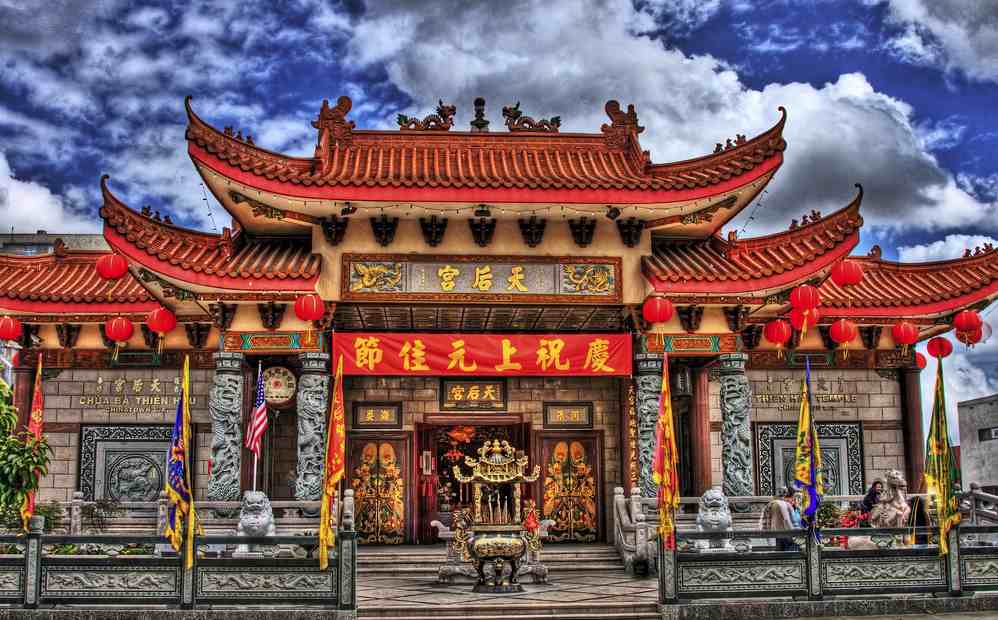 |
A ceremonial drum and bell can be seen hanging next to the massive
columns at the temple’s entrance. The front doors represent the
traditional door guard deities, and on the sides one can find the gods
of the four directions. Inside the temple are panels carved of pure
granite representing dragons (on the right wall) and tigers (on the left
wall).
Note the stone Fu dogs at the front entrance of the temple. Also the
ceremonial urn which traditionally was used by villagers to pray for
good weather (thus its location outside the temple). Many people ask
about the stone horse. It is said that children who crawl under it are
protected from harm. |
|
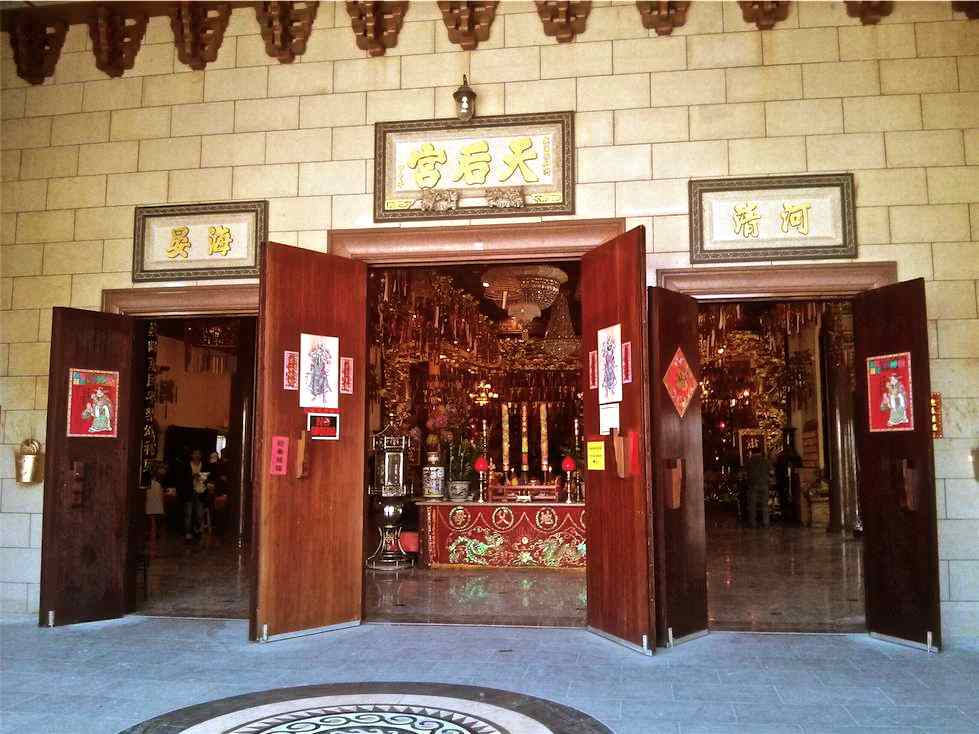 |
The Goddess Mazu, also spelled Matsu,
Tin Hou in Cantonese, Thien Hau in Vietnamese; is the indigenous goddess
of the sea who protects fisherman and sailors, and is invoked as the
goddess who protects East Asians who are associated with the ocean. Her
mortal name is Lin Moniang. She is widely worshiped in the south-eastern
coastal areas of China and neighboring areas, especially Zhejiang,
Fujian, Taiwan, Guangdong, and Vietnam, all of which have strong
sea-faring traditions, as well as migrant communities elsewhere with
sizable populations from these areas.
According to the legend, Lin Moniang was born in 960 as the seventh
daughter of Lin Yuan on Meizhou Island, Fujian. She did not cry when she
was born, and hence her given name means “Silent Girl”. According to
legend, Lin Moniang’s father and brothers were fisherman. She wore red
garments while standing on the shore to guide fishing boats home, even
in the most dangerous and harsh weather. After her death, the families
of many fisherman and sailors began to pray in her honor of her acts of
courage in trying to save those at sea.
Mazu is usually depicted wearing a red robe in paintings or murals, but
in sculpture is clothed in the robes of an empress holding a ceremonial
tablet and wearing the easily recognized flat-topped imperial cap with
hanging beads front and back. Mazu is usually depicted together with two
guardian Generals.
Her believers come to the temple to worship her with food offerings,
incense offerings, and donations. To ask a question, they shake a can of
sticks to see what number stick(s) falls out, and then consult slips of
yellow papers arranged on the wall that decipher the number into a
message. |
|
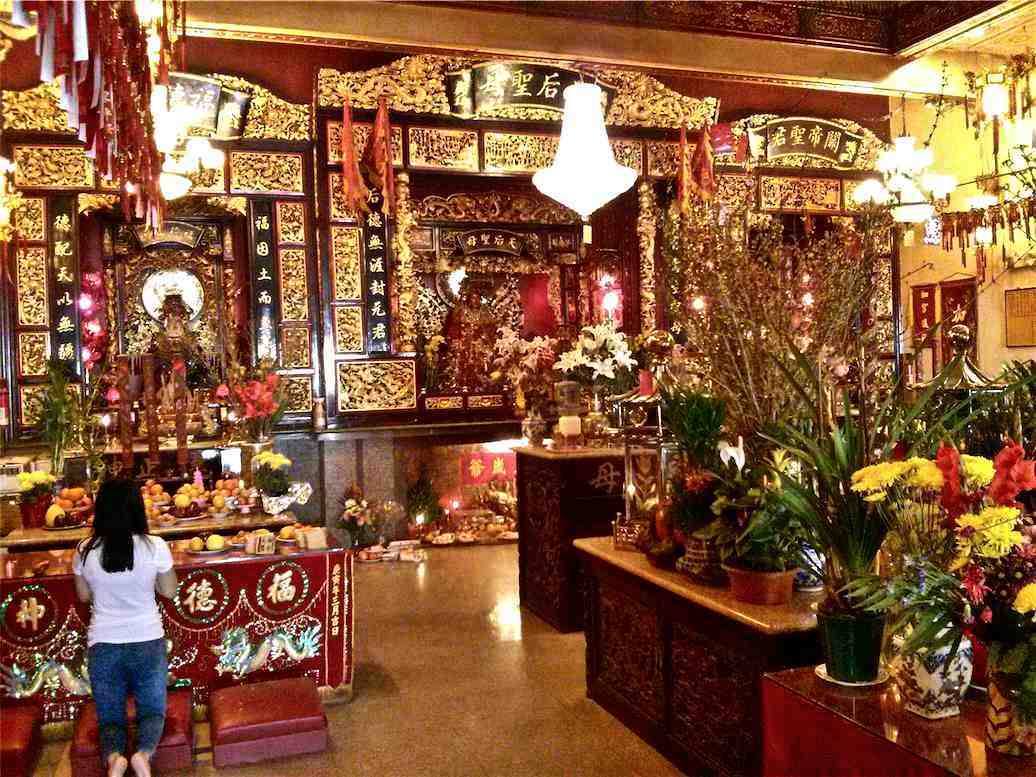 |
|
Deities at the Main Altar |
The figure on the right is Guang Gong (Kuan Ti), the God of
War and the protector of the Heavens. He is always shown with a red face
and a spear at hand. He is also the deity associated with money. The
figure in the middle is Mazu, the goddess and protector of
fishermen and coastline areas. The figure on the left is Fu De,
the Earth Deity and the deity associated with actions and deeds.
Underneath the main altar is a niche with a Tiger. People born in
the year of the current astrological sign make offerings--particularly
of meat--to the tiger to encourage him to “eat” or destroy any evil or
negativity associated with their sign.
On both sides of the sanctuary are niches holding replicas of the
goddess inscribed with the names of deceased individuals or living
families. It is believed that those named receive blessings by virtue of
their proximity to the altars. Food offerings in the way of fruit,
cooking oil, bags of rice, etc. are collected by the temple and used in
cooking (primarily vegetarian) meals for the poor on temple feast days.
A list of dates is printed and circulated in the community so that
people know they can come and receive a free meal on those days.
Incense is available on a complimentary basis at the temple because
individuals donate it believing that if someone uses their incense to
worship the goddess, they will receive blessings too. If one wants to
make sure that the goddess knows it is he/she that is worshipping, one
should either bring one’s own incense, or pay for whatever incense used,
paying as much or as little as one wishes. |
|
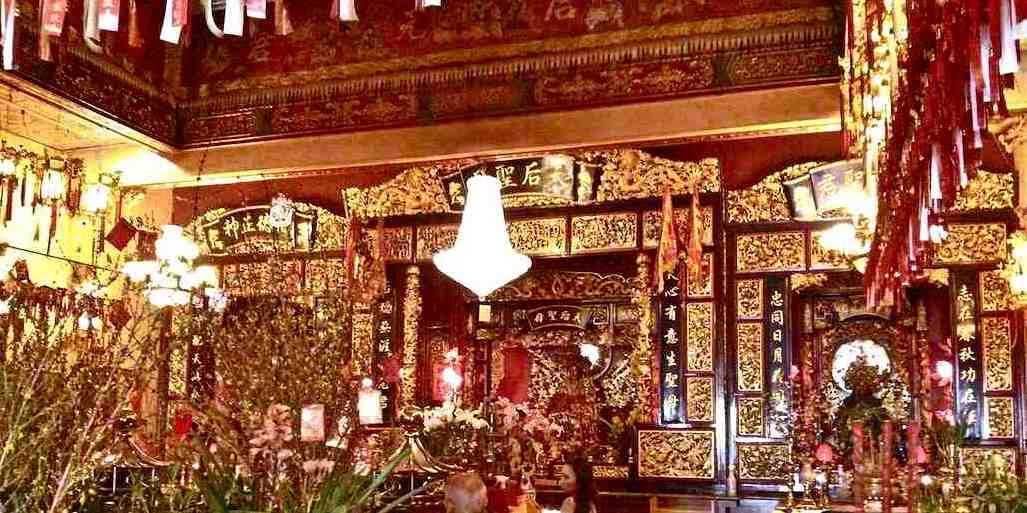 |
|
Side Chapel for Deceased - The gallery to the
right of the main temple is dedicated to ancestors. When someone in the
community dies, a table is set up to the side of the altar with a photo
of the deceased, offerings and incense. This remains in place for 10
days before being taken down. Then, one can purchase a miniature red
headstone/plaque and inscribe it with the name of the deceased. It is
placed behind the altar in one of the many niches.
The deity figure here is Quan Yin, to the Taoists a female "Goddess of
Mercy", and to the Buddhists, a male "Deity of Mercy". She is a figure
universally recognized and worshiped by Taoists and Buddhists. |
| Other Chinatown Temples - Los Angeles Chinatown is home to
six temples. In addition to these, most of the family associations have
ancestral shrines that are sometimes confused with temples. |
|
Ancient Chinese Moon
Mountain Temple |
|
Built more than 800 years ago, the Moon Mountain
Temple is famous for its beautiful scenery in the mountains. Yuntai
Mountain is magnificent for its unique geological landforms and rich
natural resources. Covered with lush original forests, the mountain has
several deep valleys and ponds, lots of waterfalls and springs, and
perilous cliffs and peaks.
Along with the Shaolin and Baima Temples, Yue Shan (Moon Mountain) is
one of the three major Temples in Central China. There were more than
800 monks living at the Temple in the past.
The site is also a famous Kung fu center where the martial art Baji
originated. |
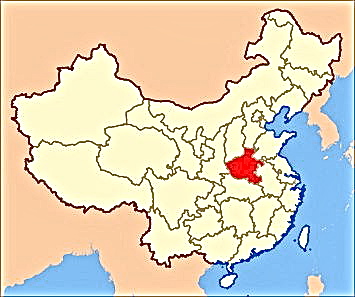 |
| Not far from Five Dragons Peak, the Moon Mountain Temple has
several interesting features, such as the Peony Garden and the Purple
Golden Pavilion. If you visit during festivals, you will hear a
deafening bell reverberates from a distance. It is not the common bell.
In fact, the bell is on the top of the Golden Pavilion. Besides from its
deep heavy sounds, because of its location, it is often mixed with the
Yellow River's rumble and creates enormous reverberations. In the
wilderness, the reverberation rises and falls in waves. |
|
The Moon Mountain Temple in Henan Province is now
covered in snow and ice which has seemed to make the Temple even more
mysterious. Snowfall at the Temple is rare, so this frosty scene is
attractive. |
| Situated adjacent to Moon Mountain Temple, the Camel Mountain
Range is most famous for its figure of Yu the Great (2,070 B.C. - 2,061
B.C.), which is a highlight on the main peak. Have you heard about Yu
the Great? He was a beloved and legendary ruler in China's prehistoric
times, and was the first King of the Xia Dynasty. To commemorate his
significant contributions on the battle against floods, the sculpture of
Yu the Great was set. |
|
The Well-known Yuntai Heaven Waterfall with a
Height of 314 Meters |
|
Yuntai Mountain - Henan Province
China |
|
Taoist Temple of
Heaven - Beijing, China |
|
The Temple of Heaven, literally the Altar of
Heaven, is a complex of Taoist buildings situated in southeastern
Beijing.
The Emperors of the Ming and Ching Dynasties visited the complex
annually when they prayed to Heaven for good harvests.
It is regarded as a Taoist Temple, but Chinese Heaven Worship, by the
reigning Emperor of the day, actually pre-dates Taoism. |
The Temple of Heaven was first constructed in 1420, the 18th
year of the reign of Ming Emperor Yongle, and was extended and renovated
during the reigns of Ming Emperor Jiajing and Ching Emperor Qianlong. It
was the place where the emperors of the Ming and Ching Dynasties would
worship the "God of Heaven" and pray for good harvest. Covering
an area of 273 hectares, it is the largest architectural complex in the
world for rituals to pay homage to Heaven.
In 1912, the Temple of Heaven was turned into a park, and opened
to the public, following the Chinese Revolution that overthrew the Ching
Dynasty and formed a Republic. Commoners who had previously been banned
from even watching the Emperor's procession pass through the city, were
now permitted to visit the Temple of Heaven itself.It quickly
attracted masses of visitors from home and abroad on a grand scale.
In 1998, the Temple of Heaven was inscribed on the World Heritage
List by the UNESCO. With profound cultural connotations and imposing
architectural styles, the Temple of Heaven is considered a
reflection of the ancient civilization of the Orient. |
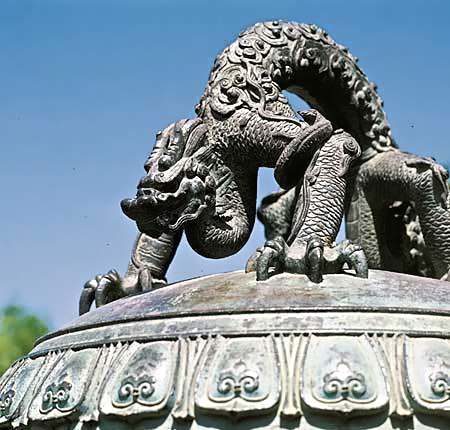 |
| When going into the Temple of Heaven, a feeling of solemnity,
respectfulness, holiness and quietness well up in the Spirit. When
looking at the beautiful sacrificial altars, one will feel the soul is
purified and thoughts sublimed. Old cypress trees surround the
buildings, creating an appropriately spiritual atmosphere. |
|
It was here the Emperor conducted the elaborate and
most exalted sacrifices addressed to:
“Supreme Ruler of the Universe - The Jade Emperor" |
|
The area of the Temple of Heaven is more than
twice that of the Imperial Palace. The Temple is more than twice the
size of the Forbidden City, because this is the space representing
Heaven on Earth, and so symbolically it needs to be bigger. It is about
2 kilometers from north to south. Indeed, it is the largest group of
constructions for worship in the world. The three main structures used
in the sacrifices are circular, corresponding to the shape of Heaven.
The glazed tile roofs of the buildings are deep blue and the platforms
constructed of slabs of white marble. Each of the three platforms
consists of three tiers, making a total of nine tiers-nine in Chinese
cosmology representing Heaven. The number and layout of every single
slab used in the platforms is determined according to cosmological
principles.
The five architectural groups in the Temple of Heaven
are given respective features. The magnificent "Hall of Prayer for
Good Harvests" is the major symbol. The Temple is divided by two
enclosed walls, into inner altar and outer altar. This to better
symbolize Heaven and Earth. The Temple's two walls have the inner
reserved for important sacrificial structures and the outer occupied by
auxiliary buildings. The northern part of the Temple is
circular while the southern part is square, which again reflects the ancient
Chinese belief that Heaven is round and the Earth is square.
Located in the northern part of the Temple of Heaven
is the 'Altar of Prayer for Good Harvests', where the Emperors
sacrificed animals and burned incense sticks to pray for good weather
for the crops; while in the southern part is the 'Circular Mound
Altar' where Emperors held ceremonies for worshipping the Heaven.
Two principle clusters of worship buildings are connected by the Red
Stairway Bridge. Additionally, in the Temple are the Hall of
Abstinence where Emperors held fasts before the ceremony, and the
Divine Music Hall, an imperial organization in charge of performing
during the ceremony. |
|
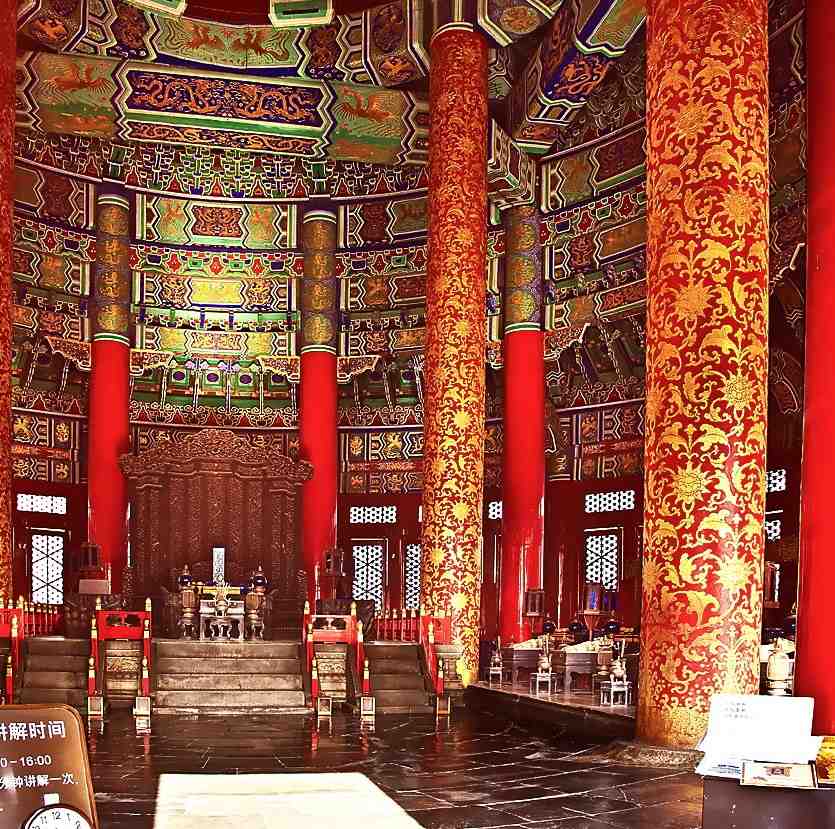 |
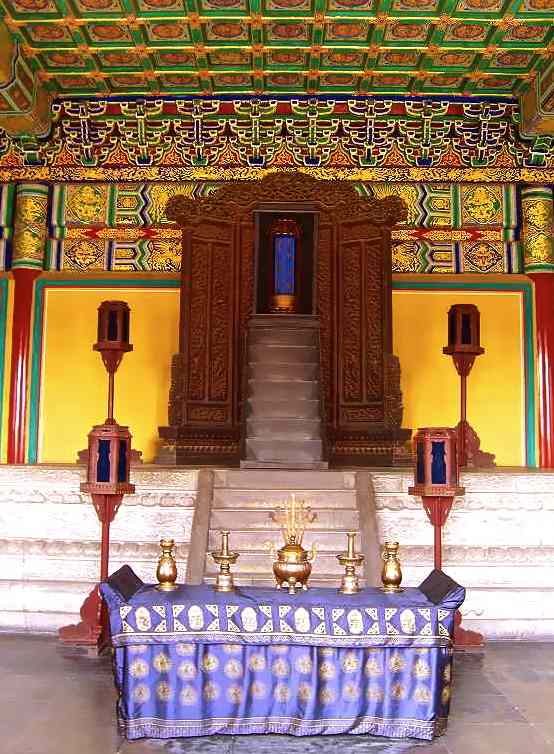 |
|
Temple of Heaven Interior |
Imperial Vault of Heaven |
The Hall of the Imperial Heavenly Vault at the southern end
of the Bridge of Cinnabar Steps served as storehouse for the spirit
tablet of the Supreme Ruler of the Universe.
When the ceremonies were conducted, the tablet was moved to the Altar
of Heaven, located directly to the south of the Hall of the Imperial
Heavenly Vault. During the sacrifices, worship was offered to the
Supreme Ruler of the Universe, to the spirits of the sun, moon, stars,
clouds, rain, wind and thunder, as well as to the emperor’s ancestors. |
|
Gate to the Altar of Heaven |
Standing at the Heavenly Center Stone on top of the
Altar to Heaven |
The construction of the Altar of Heaven was begun in 1530. It was
rebuilt once in 1749. Because the sacrifices were made to Heaven, it was
thought best to leave the structure open to the sky. Because a circle
symbolizes Heaven, the platform is round.
The Altar of Heaven is constructed of three tiers of green and white
marble, the circumference of each tier being fitted with a white marble
balustrade. The surface of the platform, the stairs and the railings are
made up of stone slabs in multiples of nine. This is drawn from the
ancient Chinese belief that nine was the numerical epitome of Yang, the
positive force, and symbolized Heaven. The top platform is 33.3 meters
in diameter and has a circular stone in the center, which was considered
the most sacred spot in the Chinese empire.
A person standing in the center of the altar who speaks softly will hear
the echo of his own voice. Others on the platform will not hear it
because the sound echoes off the surrounding balustrade and returns
directly to the center of the circle.
In addition, if one stands on the first flagstone at the bottom of the
staircase which leads up to the southern entrance door of the Hall of
the Imperial Heavenly Vault and claps or shouts loudly, a single echo is
produced; standing on the second flagstone, a double echo is produced;
and on the third flagstone, a triple echo can be heard.
Also, in the same courtyard, if two people stand at the east and west
extremes of the circular “Echo Wall ”and speak softly, the sound will be
propelled around to the person on the opposite side. |
|
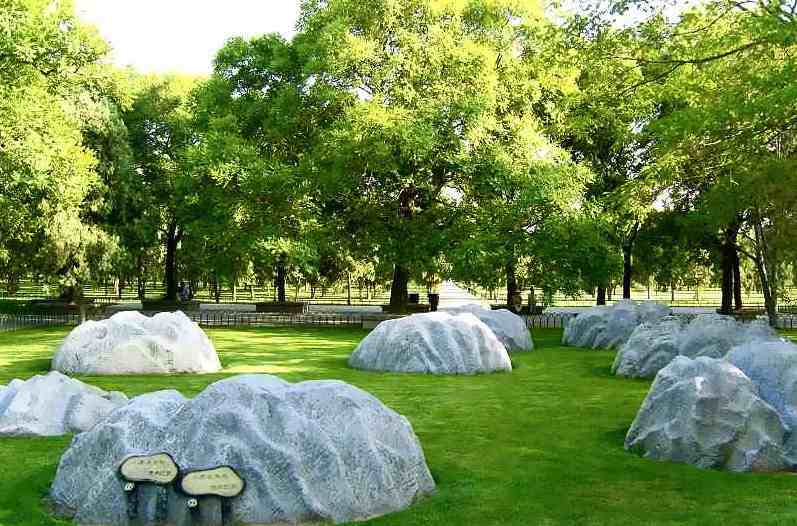 |
|
The Celestial Pacifying Stones |
|
These giant pacifying stones were
placed here during the reign of Emperor Jia Jing. They have motifs of
mountains engraved on them symbolizing the seven peaks of the Tai Shan
mountains. They are not meteors as sometimes said in folklore. |
A bi-annual procession consisting of thousands of eunuchs and
ministers, plus the Emperor, the Son of Heaven, would make its
way from the Forbidden City to the Temple of Heaven. Ordinary citizens
were not allowed to watch, or even see, the procession.
At the Temple of Heaven, the emperor would perform sacrifices and other
rituals. First, the emperor would fast in the Hall of Abstinence for
several days.
Offering sacrifices was a serious task - the entire empire relied on the
emperor for good fortune and abundant harvests so he had quite a
responsibility. News of the ceremony was then disseminated throughout
China. |
|
Snow Carpet for Temple of Heaven |
|
Beijing's Largest Taoist Monastery |
|
This Taoist Temple is one of China's
oldest and largest, it is home to the Taoist Association of China
Situated in the West City District of Beijing, the White
Cloud Taoist Temple formally reopened in 1984 for the first time since
1949
It is titled - “The First Temple Under Heaven”
It houses a large collection of Taoist literature |
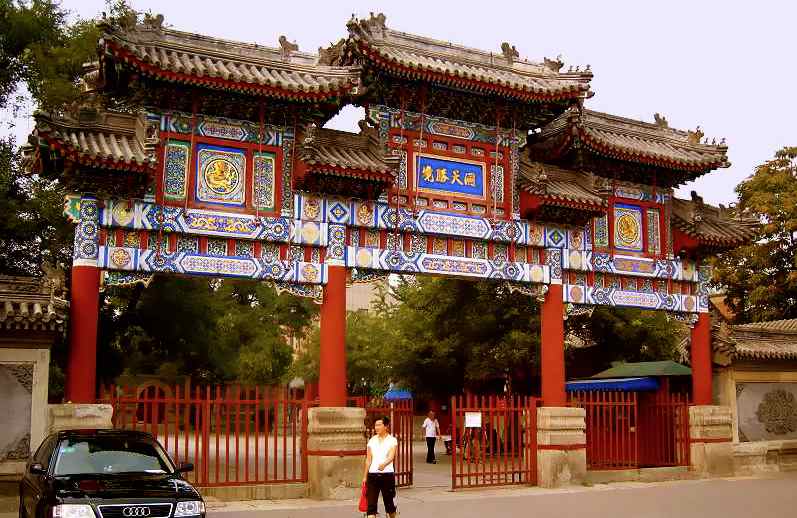 |
White Cloud Temple
Taoism is the belief in striving for immortality. It is
a following of the Tao. A "Way" of life. Over time Taoism became a
religion and Lao Tzu is regarded as a deity today (there are many
others).
In the 8th century, Tian Chang Temple was built
in Beijing to house a statue of Lao Tzu. Although it burned down in
1202, in 1224 Genghis Khan ordered the temple to be reconstructed. The
temple received its present name during the Ming Dynasty (1368-1644).
The temple was damaged by war or fire and rebuilt several times. Today,
it is more or less the same as after a major renovation in 1706.
There are three monkeys depicted in relief sculptures
around the temple. It is believed to be lucky to find all three and rub
them with your hand. |
In the first courtyard, under the span of an arched bridge, hang two
large, ancient, coin-models with two small bells in their holes. Ringing
the bells with a well-tossed coin is said to bring wealth.
In the main courtyards, the Shrine Hall for Seven Perfect Beings is
lined with meditation cushions and low desks. Nearby is a museum of
Taoist history. In the western courtyard, the temple's oldest structure
is a shrine housing the 60-Year Protector. |
|
Beijing, China: January 23rd, 2014
The Kitchen God's Day begins Worship Season
Kitchen God - Zao Shen is one of the most important deities in Taoism
and protects the hearth and family
On the twenty-third day of the twelfth lunar month, just
before New Year, he is said to return to heaven to report the activities
of every household over the past year to the Jade Emperor who either
rewards or punishes a family based on Zao Shen's annual report |
|
"I have come here every year for decades, to burn
incense to the kitchen god and meet fellow devotees," said a woman in
her 70s. Taking three sticks of incense from her bag, she lit them,
bowed to the gods with the burning incense in her hands, then put them
in a censer in front of the altar. "I also come here on the eve of
Spring Festival Eve every year. It will be too crowded on Spring
Festival," she said.
"The upcoming Spring Festival will bring a tremendous number of people,
more than 40,000, to offer incense in the temple and worship the gods,
including the Jade Emperor, Cai Shen, god of wealth, and Men Shen, the
door god," said Senior priest Meng Zhiling, deputy secretary of the
Chinese Taoist Association.
Priests will be on duty to greet visitors and maintain order. Scores of
security guards have been employed to assist with emergency plans to
control crowds. The police will take care of security and any traffic
problems around the temple, Meng added.
On Wednesday, Chinese Buddhist and Taoist figures called for an end to
what they perceive as "uncivilized" behavior when offering incense at
religious sites, and environmentally friendly ways to burn incense
during Spring Festival to reduce air pollution.
"Piety is not determined by the price and length of the incense which is
only as a channel to deliver the message of the pilgrim," said Meng. "A
pure mind and harmony with nature are the best ways to worship." |
|
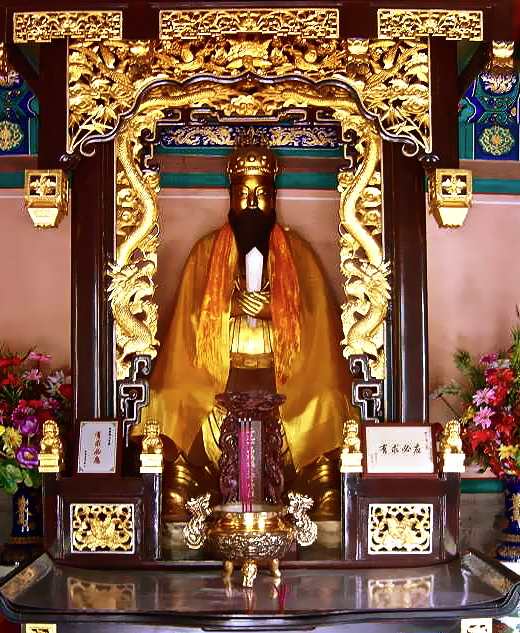 |
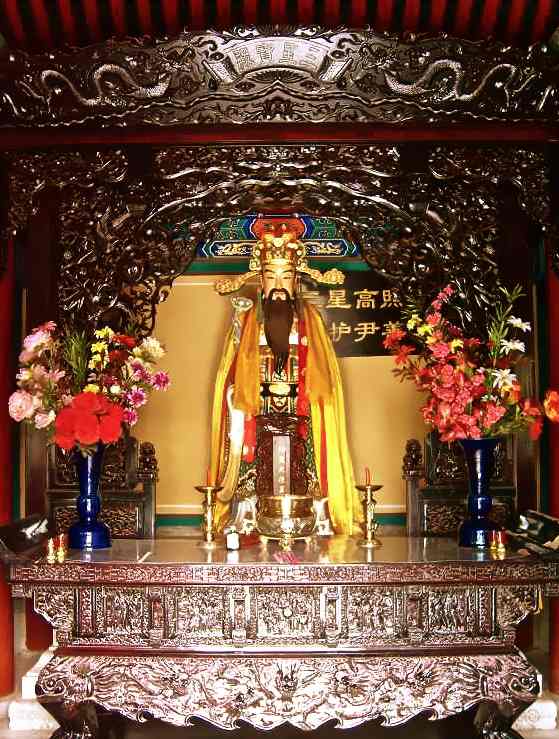 |
|
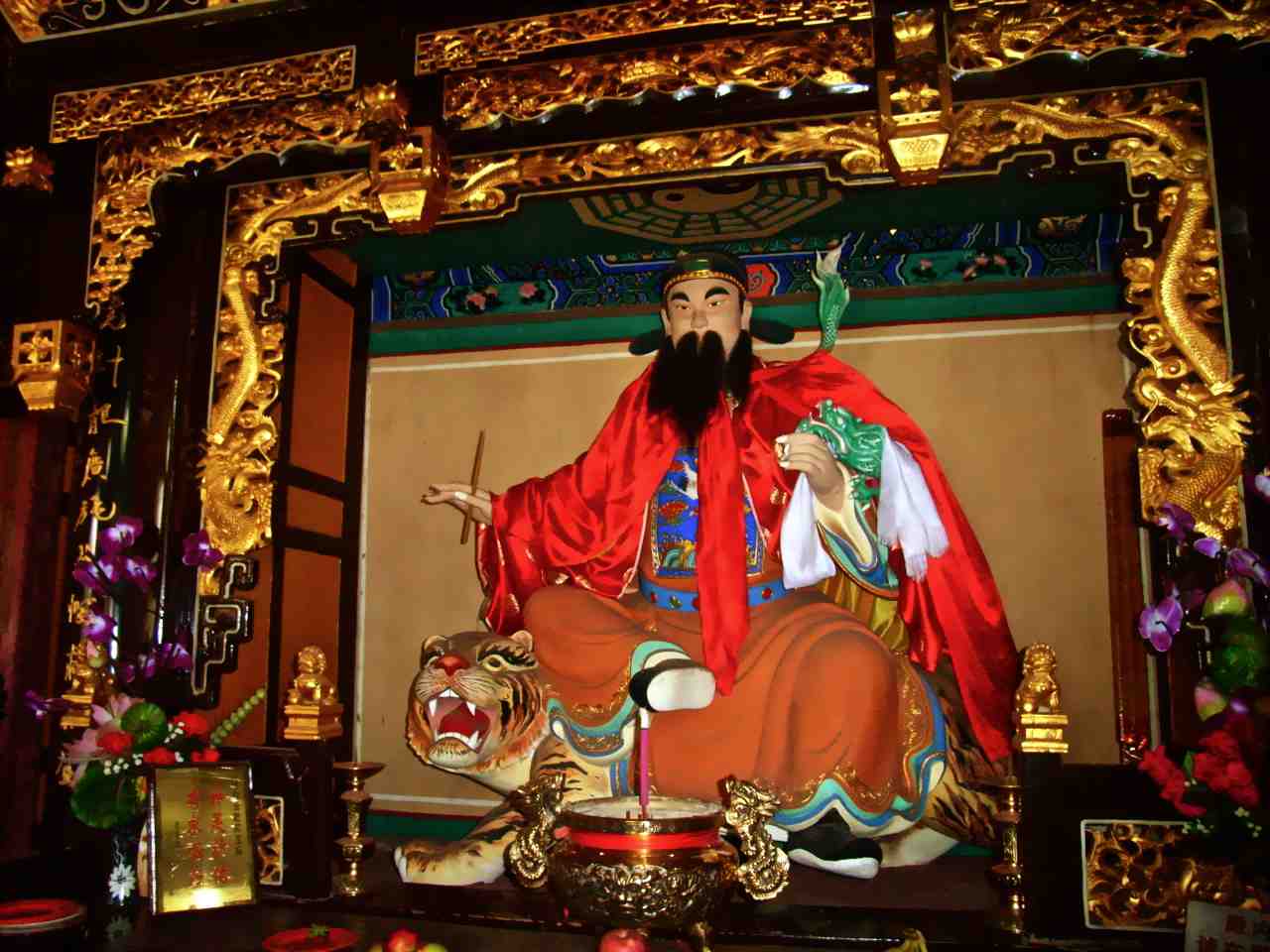 |
|
The Golden Temple is a famous Taoism temple in
Yunnan Province. Located on the charming Mingfeng Hill (Singing Phoenix
Hill), 15 kilometers from the east Kunming urban area, the Golden Temple
is also known as Taihe Palace (Hall of Supreme Harmony) or Tongwa Temple
(Bronze Tile Temple). It is the largest copper architecture in China. |
Golden Temple was firstly built in 1602 during the Ming
Dynasty (1368–1644), imitating the design of the Taihe Palace in Wudang
Mountain of Hubei Province. The temple hall is 6.7 meters in height, and
weighs 250 tons. All of the beam columns, doors, windows, roof tiles,
statues, wall decorations, the banner near the gate and couplets, are
made of bronze. The burnished bronze gleams like gold under the shining
sun, hence the temple got its name.
Like most of the Taoist temples, visitors must climb hundreds of winding
stone steps on the mountainside and get through three "Heavenly Gates,"
which are highly decorated with well-painted archivolts and carded beams
and rafters before approaching the temple. The stone steps are
surrounded by beautiful scenery, and while climbing the stone steps, you
could feel a sense of inner peace as they integrate themselves into the
beauty of Mingfeng Hill. |
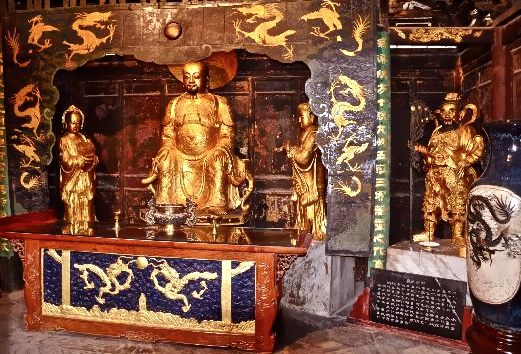 |
|
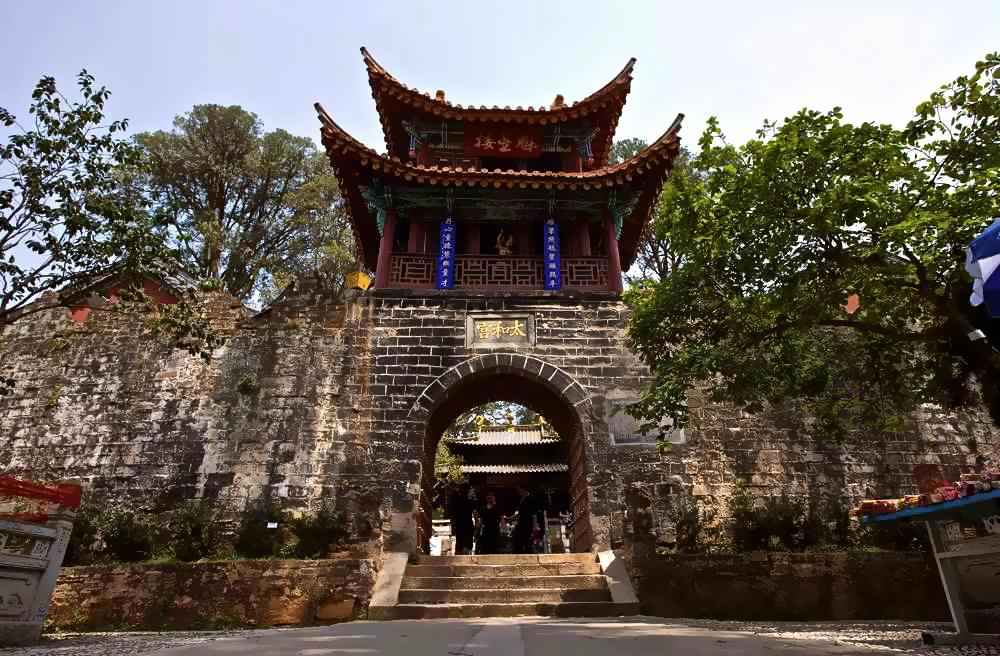 |
| At the end of the stone path is situated a miniature city wall built
along with Lingxing Gate (the gate leading to the temple) and
battlements. Inside Taihe Palace, numerous historical objects are on
display. Among these objects is a double-edged sword with the Big Dipper
engraved on it. The sword weighs 20 kilograms. It is said that this is
the magic sword of Zhen Wu, a Taoist deity who guards Mingfeng Hill.
Another broadsword with a wooden handle is said to be the saber of Wu
Sangui (Qing Dynasty), and weighs 12 kilograms (about 24.5 pounds).
Behind the temple, is planted a Camellia Tree signaling the
approach of spring every February with its hundreds of exquisite
blossoms. Visitors could also find larger Striemia Indica Trees.
These trees, over 600 years old, add more energy to the quiet temple. |
|